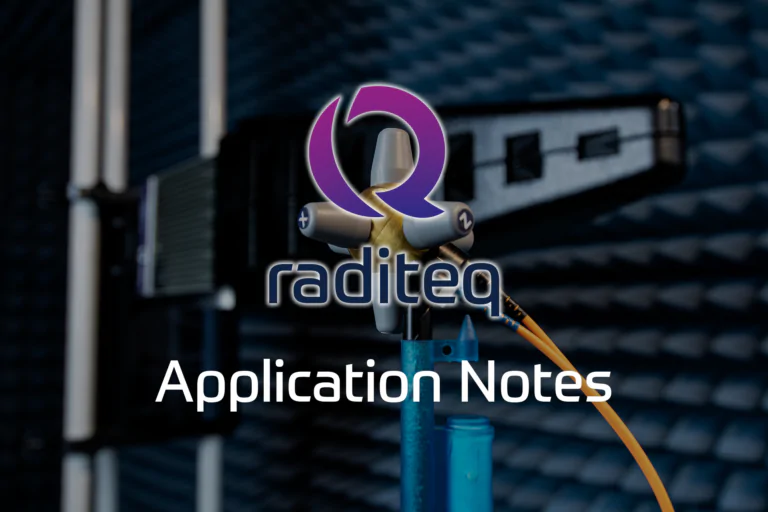Isotropic Importance in EMC Testing: Ensuring Accuracy with RadiSense® 10 and RSS2040 E-Field Probes
In electromagnetic compatibility (EMC) testing, the accuracy of electric field (E-field) measurements is paramount. EMC testing labs rely on E-field probes to determine the electric field strength generated during radiated immunity testing. These probes serve as the absolute reference for verifying the generated electric field strength’s value, making their precision crucial. Over time, manufacturers have specified probe accuracy in various ways, often leading to confusion among users who must combine uncertainties from several parameters like linearity, frequency response, temperature drift, and non-isotropic behavior. This article aims to elucidate the importance of isotropic behavior in E-field probes and introduce RadiSense® 10 and RSS2040 E-field probes as superior solutions.
Understanding Isotropic Response
An E-field probe with perfect isotropic response provides consistent electric field strength readings, irrespective of its orientation in the field. Practically, however, all E-field probes exhibit some degree of non-isotropic behavior due to factors such as detector differences along the x, y, and z axes, sharp edges of the probe housing causing eddy currents, mounting supports, and fiber optic connections.
Measuring Isotropic Response
Accurately measuring isotropic response involves scanning the probe’s spherical surface at every frequency used—a highly time-consuming process. In practice, two methods are commonly used:
- Balance Between Axes: During calibration, an electric field is generated in one orientation (e.g., vertical). The x, y, and z-axis elements are aligned with the field sequentially. The differences measured between the axes represent the imbalance, often reported as isotropic response, though this covers only part of the isotropic response under ideal conditions.
- Rotational Symmetry: In an anechoic calibration chamber, the probe is positioned at a 54.7-degree angle to the field orientation (the “magic angle”). By rotating the probe 360 degrees, each axis aligns with the field every 120 degrees. This method assesses the worst-case isotropic behavior, providing a circular diagram that reveals both axis balance and intermediate responses.
Importance of Isotropic Probe Behavior
Anechoic chambers typically generate fields in one orientation (horizontal or vertical). It might seem that a probe aligned with one axis parallel to the field could measure field strength accurately even with poor isotropic response. However, real-world field distribution is imperfect, as evidenced by the EN61000-4-3 standard, which allows a 6 dB error margin for field homogeneity in anechoic chambers. Reflections within the chamber can lead to incorrect measurements, resulting in unjustified room rejections or approvals during the 16-point calibration and erroneous field strength measurements during EMC testing.
The belief that a probe doesn’t need to be isotropic because the field is in one orientation is flawed. The 16-point calibration aims to ensure field homogeneity, underscoring the necessity for isotropic probes.
Specifying Isotropic Behavior
Manufacturers traditionally specify isotropic response at a single low frequency. However, isotropic response varies significantly with frequency, performing well at low frequencies but deteriorating at high frequencies. At low frequencies, the probe’s dimensions are small relative to the wavelength, resulting in good isotropic response. At higher frequencies, the probe’s dimensions become significant compared to the wavelength, causing greater isotropic deviations.
High-Frequency Isotropic Performance
Specifications often cover frequencies below 2 GHz, where isotropic performance appears acceptable. However, measurements of various probes from well-known manufacturers show isotropic errors ranging from 6 to 10 dB between 3 and 6 GHz, highlighting the critical importance of isotropic behavior at higher frequencies.
RadiSense® 10 and RSS2040 E-Field Probes: Superior Anisotropic Performance
The RadiSense® RSS2010I (9 kHz to 12 GHz), RSS2010S (20 MHz to 12 GHz), and RSS2040 models set new industry standards for precise and reliable field probe measurements in diverse applications. Developed with over 25 years of expertise, these probes deliver exceptional anisotropic response across their entire frequency range.
Anisotropic Performance of the RadiSense® RSS2040
Accurate measurements depend on the anisotropic performance of E-Field probes, as non-isotropic behavior leads to significant inaccuracies. Thorough testing and analysis of this property are essential, especially at higher frequencies. Therefore, it is crucial to define this specification across the entire frequency range of each probe.
RadiSense® probes are engineered to provide consistent and precise field strength readings from any angle of incidence. This makes them ideal for various test environments, including (G)TEM cells, strip lines, anechoic chambers, and reverberation chambers, where accuracy is crucial.
Key Features and Benefits
- High Precision & Accuracy: RadiSense® probes deliver unmatched low anisotropic behavior, ensuring accurate readings regardless of the electromagnetic signal’s angle of incidence.
- Wide Frequency Range: Covering a broad spectrum, these probes are suitable for various test environments.
- Reliability: Designed for precision in EMC immunity testing, RadiSense® probes ensure the integrity and accuracy of measurements, crucial for both complex research and regulatory compliance.
Why Choose RadiSense® E-Field Probes?
At Raditeq, they recognize the critical role of precision in EMC immunity testing. RadiSense® probes are more than just tools; they are essential partners in ensuring the integrity and accuracy of your tests. As the sole reference in your EMC test environment, RadiSense® probes guarantee correct test levels, reducing the risk of under-testing. Whether conducting complex research or ensuring regulatory compliance, you can trust RadiSense® for reliable results.
Conclusion
The isotropic behavior of E-field probes is vital for accurate EMC immunity testing. Misinterpretations and poor specifications can lead to significant errors in testing environments. The RadiSense® 10 and RSS2040 E-field probes provide a solution with their superior anisotropic performance, ensuring precise and reliable measurements across a wide frequency range. For those conducting complex research or ensuring regulatory compliance, RadiSense® probes offer the confidence needed for accurate EMC immunity testing.

